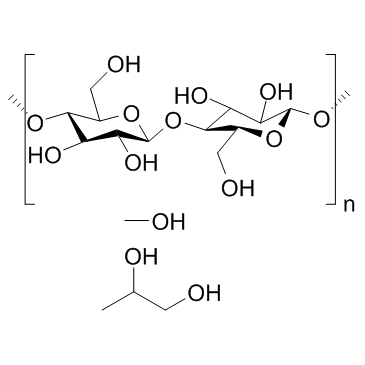Hypromellose (Celacol HPM 5000) |
| Catalog No.GC30070 |
Hypromellose (Celacol HPM 5000) is a hydrophilic, non-ionic cellulose ether used to form swellable-soluble matrices.
Products are for research use only. Not for human use. We do not sell to patients.

Cas No.: 9004-65-3
Sample solution is provided at 25 µL, 10mM.
Hypromellose is a water-soluble hydrophilic, non-ionic cellulose ether used to form swellable-soluble matrices.
Hypromellose provides the release of a drug in a controlled manner, effectively increasing the duration of release of a drug to prolong its therapeutic effect[1]. Hypromellose (hydroxypropylmethylcellulose) has been used in sustained-release pharmaceutical products for many years. When used in matrix tablets, these polymers hydrate on contact with water to produce a viscous gel barrier within and surrounding the tablet. The properties of hypromellose that affect the rate of drug release include the rate of diffusion of water into the dry polymer, the rate of hypromellose hydration and gel formation, the viscosity of the hydrated hypromellose and rate of hypromellose gel erosion[2].
Punctal occlusion using hypromellose 2% is a low-cost and safe additional treatment for dry eye. Fluorescein and rose bengal staining tests show that there was a significant reduction in signs after occlusion using hypromellose[3]. Hypromellose is effective in improving the blood glucose metabolism and suppressing oxidative stress in mice fed with a high fat diet. The antihyperglycemic and antioxidative effects of hypromellose could be partly attributed to the regulation of hepatic glucose-regulating enzyme activities and activation of the hepatic and erythrocyte antioxidant enzymes. Hypromellose may be useful as biomaterials in the development of functional food or as therapeutic agents against high fat-induced hyperglycemia and oxidative stress[4].
[1]. Li CL, et al. The use of hypromellose in oral drug delivery. J Pharm Pharmacol. 2005 May;57(5):533-46. [2]. Braund R, et al. Hypromellose films for the delivery of growth factors for wound healing. [3]. Capita L, et al. Prospective evaluation of hypromellose 2% for punctal occlusion in patients with dry eye. Cornea. 2015 Feb;34(2):188-92. [4]. Ban SJ, et al. Antihyperglycemic and antioxidative effects of Hydroxyethyl Methylcellulose (HEMC) and Hydroxypropyl Methylcellulose (HPMC) in mice fed with a high fat diet. Int J Mol Sci. 2012;13(3):3738-50.
Average Rating: 5 (Based on Reviews and 16 reference(s) in Google Scholar.)
GLPBIO products are for RESEARCH USE ONLY. Please make sure your review or question is research based.
Required fields are marked with *




